A Systematic Literature Review of Various Control Techniques for Active Seat Suspension Systems
Abstract
1. Introduction
2. Biodynamic Model of the Human Body
3. Type of Vibration
4. Vibration Evaluation Metrics
4.1. The Weighted RMS Acceleration Value in ISO 2631-1: 1997
4.2. VDV Value
4.3. SEAT Value
5. Type of Suspension Systems
5.1. Multiple Degrees of Freedom Vibration
5.2. Integrated Active Seat Suspension with Vehicle Suspension
6. Actuators Used in the Active Seat Suspension System
7. Active Seating Suspension System Structure Design
8. Control Methods Used in the Active Seating Suspension System
8.1. Robust Controller
8.2. Preview Controller
8.3. Sliding Mode Controller
8.4. Adaptive Controller
8.5. PID Controller
8.6. Adaptive Neuro Fuzzy Interference System
8.7. Hybrid Controller
8.8. Other Control Techniques
9. Our Contributions
Research Gaps and Research Questions
- What innovative seat suspension structure should be used to implement the actuator and control algorithm within?
- What type of MPC can be used to improve the driver comfort for active seat suspension system?
- How can the Kalman filter be used to estimate the disturbances for active vibration seating system?
10. Conclusions
Author Contributions
Funding
Conflicts of Interest
References
- Paddan, G.; Griffin, M. Effect of seating on exposures to whole-body vibration in vehicles. J. Sound Vib. 2002, 253, 215–241. [Google Scholar] [CrossRef]
- Cinquemani, S.; Cutini, M.; Abbati, G.; Meloro, G.; Sabbioni, E. Experimental Assessment of the Effect of Different Tires on Comfort of Construction Truck Operators. In Special Topics in Structural Dynamics; Springer: Cham, Germany, 2019; Volume 5, pp. 249–257. [Google Scholar]
- Demic, M.; Lukic, J.; Milic, Z. Some aspects of the investigation of random vibration influence on ride comfort. J. Sound Vib. 2002, 253, 109–128. [Google Scholar] [CrossRef]
- Pope, M.H.; Magnusson, M.; Wilder, D.G. Low Back Pain and Whole Body Vibration. Clin. Orthop. Relat. Res. 1998, 354, 241–248. [Google Scholar] [CrossRef] [PubMed]
- Mansfield, N.J. Impedance methods (apparent mass, driving point mechanical impedance and absorbed power) for assessment of the biomechanical response of the seated person to whole-body vibration. Ind. Health 2005, 43, 378–389. [Google Scholar] [CrossRef][Green Version]
- Wang, W.; Rakheja, S.; Boileau, P.-É. Relationship between measured apparent mass and seat-to-head transmissibility responses of seated occupants exposed to vertical vibration. J. Sound Vib. 2008, 314, 907–922. [Google Scholar] [CrossRef]
- Kumar, V.; Saran, V. Seat-to-Head Transmissibility and Reading Discomfort of the Seated Subjects Exposed to Whole Body Vibration. Int. J. Acoust. Vib. 2016, 21, 67–74. [Google Scholar] [CrossRef]
- Dobry, M.W.; Hermann, T. A comparison of human physical models used in the ISO 10068: 2012 standard based on power distribution. Part 1. Vib. Phy. Syst. 2014, 26, 49–56. [Google Scholar]
- Coyte, J.L.; Stirling, D.; Du, H.; Ros, M. Seated whole-body vibration analysis, technologies, and modeling: A survey. IEEE Trans. Syst. Man Cybern. Syst. 2015, 46, 725–739. [Google Scholar] [CrossRef]
- Wen, S.; Chen, M.Z.; Zeng, Z.; Yu, X.; Huang, T. Fuzzy control for uncertain vehicle active suspension systems via dynamic sliding-mode approach. IEEE Trans. Syst. Man Cybern. Syst. 2016, 47, 24–32. [Google Scholar] [CrossRef]
- Huang, Y.; Na, J.; Wu, X.; Liu, X.; Guo, Y. Adaptive control of nonlinear uncertain active suspension systems with prescribed performance. ISA Trans. 2015, 54, 145–155. [Google Scholar] [CrossRef]
- Zhao, F.; Ge, S.S.; Tu, F.; Qin, Y.; Dong, M. Adaptive neural network control for active suspension system with actuator saturation. IET Control Theory Appl. 2016, 10, 1696–1705. [Google Scholar] [CrossRef]
- Ning, D.; Du, H.; Sun, S.; Li, W.; Li, W. An energy saving variable damping seat suspension system with regeneration capability. IEEE Trans. Ind. Electron. 2018, 65, 8080–8091. [Google Scholar] [CrossRef]
- Du, H.; Li, W.; Zhang, N. Integrated seat and suspension control for a quarter car with driver model. IEEE Trans. Veh. Technol. 2012, 61, 3893–3908. [Google Scholar]
- Devdutt, M. Active vibration control of passenger seat with HFPIDCR controlled suspension alternatives. Int. J. Mech. Mechatron. Eng. 2016, 10, 916–923. [Google Scholar]
- Wang, K.; Gao, F. Vibration Isolation Analysis and Optimization of Commercial Vehicle Cab Suspension System. In SAE Technical Paper 0148-7191; SAE, 2018; Available online: https://www.sae.org/publications/technical-papers/content/2018-01-1405/ (accessed on 8 February 2020).
- Kumbhar, P.B.; Xu, P.; Yang, J.J. A Literature Survey of Biodynamic Models for Whole Body Vibration and Vehicle Ride Comfort. In Proceedings of the ASME 2012 International Design Engineering Technical Conferences and Computers and Information in Engineering Conference, Chicago, IL, USA, 12–15 August 2012; American Society of Mechanical Engineers Digital Collection: Chicago, IL, USA, 2012; pp. 671–687. [Google Scholar]
- Choi, S.; Choi, J.; Lee, Y.; Han, M. Vibration control of an ER seat suspension for a commercial vehicle. J. Dyn. Sys. Meas. Control 2003, 125, 60–68. [Google Scholar] [CrossRef]
- Liang, C.C.; Chiang, C.F. A study on biodynamic models of seated human subjects exposed to vertical vibration. Int. J. Ind. Ergon. 2006, 36, 869–890. [Google Scholar] [CrossRef]
- Wang, W.; Rakheja, S.; Boileau, P.É. Effects of sitting postures on biodynamic response of seated occupants under vertical vibration. Int. J. Ind. Ergon. 2004, 34, 289–306. [Google Scholar] [CrossRef]
- Wang, X.; Bi, F.; Du, H. Reduction of low frequency vibration of truck driver and seating system through system parameter identification, sensitivity analysis and active control. J. Mech. Syst. Signal Process. 2018, 105, 16–35. [Google Scholar] [CrossRef]
- Kitazaki, S.; Griffin, M.J. A modal analysis of whole-body vertical vibration, using a finite element model of the human body. J. Sound Vib. 1997, 200, 83–103. [Google Scholar] [CrossRef]
- Kong, W.Z.; Goel, V.K. Ability of the finite element models to predict response of the human spine to sinusoidal vertical vibration. Spine 2003, 28, 1961–1967. [Google Scholar] [CrossRef]
- Amirouche, F.; Ider, S. Simulation and analysis of a biodynamic human model subjected to low accelerations—A correlation study. J. Sound Vib. 1988, 123, 281–292. [Google Scholar] [CrossRef]
- Qassem, W. Model prediction of vibration effects on human subject seated on various cushions. Med. Eng. Phys. 1996, 18, 350–358. [Google Scholar] [CrossRef]
- Coermann, R.R. The mechanical impedance of the human body in sitting and standing position at low frequencies. Hum. Factors Ergon. Soc. 1962, 4, 227–253. [Google Scholar] [CrossRef] [PubMed]
- Wen, G.; Zhang, Z.; Yao, S.; Yin, H.; Chen, Z.; Xu, H.; Ma, C. Vibration control for active seat suspension system based on projective chaos synchronisation. Int. J. Veh. Des. 2012, 58, 1–14. [Google Scholar] [CrossRef]
- Magid, E.B.; Coermann, R. The reaction of the human body to extreme vibrations. Proc. Inst. Environ. Sci. 1960, 135, 37. [Google Scholar]
- Muksian, R.; Nash, C., Jr. On frequency-dependent damping coefficients in lumped-parameter models of human beings. J. Biomech. 1976, 9, 339–342. [Google Scholar] [CrossRef]
- Boileau, P.-É.; Rakheja, S. Whole-body vertical biodynamic response characteristics of the seated vehicle driver: Measurement and model development. Int. J. Ind. Ergon. 1998, 22, 449–472. [Google Scholar] [CrossRef]
- Zhao, Y.; Wang, X. A Review of Low-Frequency Active Vibration Control of Seat Suspension Systems. J. Appl. Sci. 2019, 9, 3326. [Google Scholar] [CrossRef]
- Randall, J.; Matthews, R.; Stiles, M. Resonant frequencies of standing humans. Ergonomics 1997, 40, 879–886. [Google Scholar] [CrossRef]
- Ning, D.; Du, H.; Sun, S.; Li, W.; Zhang, B. An innovative two-layer multiple-DOF seat suspension for vehicle whole body vibration control. IEEE Trans. Mechatron. 2018, 23, 1787–1799. [Google Scholar] [CrossRef]
- Paddan, G.; Griffin, M. Evaluation of whole-body vibration in vehicles. J. Sound Vib. 2002, 253, 195–213. [Google Scholar] [CrossRef]
- ISO. Mechanical Vibration and Shock: Evaluation of Human Exposure to Whole-Body Vibration. Part 1, General Requirements: International Standard ISO 2631-1: 1997 (E); ISO: Geneva, Switzerland, 1997. [Google Scholar]
- ISO. ISO 8041-1:2017. Human Response to Vibration—Measuring Instrumentation—Part 1: General Purpose Vibration Meters. Available online: https://www.sis.se/api/document/preview/921825/ (accessed on 28 December 2019).
- Griffin, M.J. A comparison of standardized methods for predicting the hazards of whole-body vibration and repeated shocks. J. Sound Vib. 1998, 215, 883–914. [Google Scholar] [CrossRef]
- Ciloglu, H.; Alziadeh, M.; Mohany, A.; Kishawy, H. Assessment of the whole body vibration exposure and the dynamic seat comfort in passenger aircraft. Int. J. Ind. Ergon. 2015, 45, 116–123. [Google Scholar] [CrossRef]
- Martins, I.; Esteves, M.; da Silva, F.P.; Verdelho, P. Electromagnetic Hybrid Active-Passive Vehicle Suspension System. In Proceedings of the 1999 IEEE 49th Vehicular Technology Conference (Cat. No. 99CH36363), Houston, TX, USA, 16–20 May 1999; IEEE: Piscataway, NJ, USA, 1999; Volume 3, pp. 2273–2277. [Google Scholar]
- Alkhatib, R.; Jazar, G.N.; Golnaraghi, M. Optimal design of passive linear suspension using genetic algorithm. J. Sound Vib. 2004, 275, 665–691. [Google Scholar] [CrossRef]
- Du, X.-M.; Yu, M.; Fu, J.; Peng, Y.-X.; Shi, H.-F.; Zhang, H. H∞ control for a semi-active scissors linkage seat suspension with magnetorheological damper. J. Intell. Mater. Syst. Struct. 2019, 30, 708–721. [Google Scholar] [CrossRef]
- Ning, D.; Du, H.; Sun, S.; Zheng, M.; Li, W.; Zhang, N.; Jia, Z. An Electromagnetic Variable Stiffness Device for Semi-Active Seat Suspension Vibration Control. IEEE Trans. Ind. Electron. 2019. [Google Scholar] [CrossRef]
- Gad, S.; Metered, H.; Bassuiny, A.; Abdel Ghany, A.M. Multi-objective genetic algorithm fractional-order PID controller for semi-active magnetorheologically damped seat suspension. J. Vib. Control 2017, 23, 1248–1266. [Google Scholar] [CrossRef]
- Yang, Z.; Liang, S.; Zhou, Y.; Zhao, D. Sliding Mode Control for Vibration Comfort Improvement of a 7-DOF Nonlinear Active Vehicle Suspension Model. J. Robot. Mechtron. 2019, 31, 95–103. [Google Scholar] [CrossRef]
- Ning, D.; Sun, S.; Zhang, F.; Du, H.; Li, W.; Zhang, B. Disturbance observer based Takagi-Sugeno fuzzy control for an active seat suspension. J. Mech. Syst. Signal Process. 2017, 93, 515–530. [Google Scholar] [CrossRef]
- Nevala, K.; Kangaspuoskari, M.; Leinonen, T. Development of an Active Suspension Mechanism for the Seat Vibration Damping. In Proceedings of the 4th IASTED International Conference: Robotics and Manufacturing, Honolulu, HI, USA, 19–22 August 1996; pp. 337–339. [Google Scholar]
- Bai, X.-X.; Jiang, P.; Qian, L.-J. Integrated semi-active seat suspension for both longitudinal and vertical vibration isolation. J. Intell. Mater. Syst. Struct. 2017, 28, 1036–1049. [Google Scholar] [CrossRef]
- Li, Y.; Feng, L.; Wang, Y. A cascade control approach to active suspension using pneumatic actuators. Asian J. Control 2019, 21, 70–88. [Google Scholar] [CrossRef]
- Ning, D.; Sun, S.; Du, H.; Li, W.; Li, W. Control of a multiple-DOF vehicle seat suspension with roll and vertical vibration. J. Sound Vib. 2018, 435, 170–191. [Google Scholar] [CrossRef]
- Kieneke, R.; Graf, C.; Maas, J. Active seat suspension with two degrees of freedom for military vehicles. IFAC Proc. Vol. 2013, 46, 523–529. [Google Scholar] [CrossRef]
- Yu, J.-H.; Lee, K.-C.; Park, H.-B.; Choi, Y.-G.; Ryu, K.-H. Development of 2-DOF active seat suspension system for agricultural tractor–design of mechanism and controller. In 2008 Providence, Rhode Island, June 29–July 2, 2008; American Society of Agricultural and Biological Engineers: Rhode Island, RI, USA, 2008; p. 1. Available online: https://elibrary.asabe.org/abstract.asp?aid=25007 (accessed on 8 February 2020).
- Boonporm, P.; Houdjaroen, K.; Panchomphu, C. Development of 2 DOF Truck’s Suspension Seat for Improving Ride Comfort. In Proceedings of the 2nd International Symposium on Computer Science and Intelligent Control, Stockholm, Sweden, 21–23 September 2018; ACM: New York, NY, USA, 2018; p. 7. [Google Scholar]
- Mandapuram, S.; Rakheja, S.; Boileau, P.E.; Maeda, S.; Shibata, N. Apparent Mass and Seat-to-head Transmissibility Responses of Seated Occupants under Single and Dual Axis Horizontal Vibration. Ind. Health 2010, 48, 698–714. [Google Scholar] [CrossRef] [PubMed]
- Mandapuram, S.; Rakheja, S.; Marcotte, P.; Boileau, P.-É. Analyses of biodynamic responses of seated occupants to uncorrelated fore-aft and vertical whole-body vibration. J. Sound Vib. 2011, 330, 4064–4079. [Google Scholar] [CrossRef]
- Maciejewski, I.; Krzyzynski, T.; Meyer, H. Modeling and vibration control of an active horizontal seat suspension with pneumatic muscles. J. Vib. Control 2018, 24, 5938–5950. [Google Scholar] [CrossRef]
- Hostens, I.; Ramon, H. Descriptive analysis of combine cabin vibrations and their effect on the human body. J. Sound Vib. 2003, 266, 453–464. [Google Scholar] [CrossRef]
- Qiu, Y.; Griffin, M.J. Biodynamic Response of the Seated Human Body to Single-axis and Dual-axis Vibration: Effect of Backrest and Non-linearity. Ind. Health 2011, 50, 37. [Google Scholar] [CrossRef]
- Stein, G.J.; Zahoranský, R.; Gunston, T.P.; Burström, L.; Meyer, L. Modelling and simulation of a fore-and-aft driver’s seat suspension system with road excitation. Int. J. Ind. Ergon. 2008, 38, 396–409. [Google Scholar] [CrossRef]
- Blüthner, R.; Hinz, B.; Menzel, G.; Schust, M.; Seidel, H. On the significance of body mass and vibration magnitude for acceleration transmission of vibration through seats with horizontal suspensions. J. Sound Vib. 2006, 298, 627–637. [Google Scholar] [CrossRef]
- Gündoğdu, Ö. Optimal seat and suspension design for a quarter car with driver model using genetic algorithms. Int. J. Ind. Ergon. 2007, 37, 327–332. [Google Scholar] [CrossRef]
- Kuznetsov, A.; Mammadov, M.; Sultan, I.; Hajilarov, E. Optimization of a quarter-car suspension model coupled with the driver biomechanical effects. J. Sound Vib. 2011, 330, 2937–2946. [Google Scholar] [CrossRef]
- Rajendiran, S.; Lakshmi, P. Simulation of PID and fuzzy logic controller for integrated seat suspension of a quarter car with driver model for different road profiles. J. Mech. Sci. Technol. 2016, 30, 4565–4570. [Google Scholar] [CrossRef]
- Singh, D. Ride comfort analysis of passenger body biodynamics in active quarter car model using adaptive neuro-fuzzy inference system based super twisting sliding mode control. J. Vib. Control 2019, 25, 1866–1882. [Google Scholar] [CrossRef]
- Devdutt. Passenger Seat Vibration Comparison Using ANFIS Control in Active Quarter Car Model. Int. J. Mech. Mechatron. Eng. 2017, 11, 1–7. [Google Scholar]
- Stein, G.J. A driver’s seat with active suspension of electro-pneumatic type. J. Vib. Acoust. 1997, 119, 230–235. [Google Scholar] [CrossRef]
- Shurpali, M.V.; Mullinix, L. An Approach for Validation of Suspension Seat for Ride Comfort using Multi-Body Dynamics. In SAE Technical Paper 0148-7191; SAE International, 2011; Available online: https://www.sae.org/publications/technical-papers/content/2011-01-0434/ (accessed on 8 February 2020).
- Quaglia, G.; Sorli, M. Air suspension dimensionless analysis and design procedure. Intl. J. Veh. Mech. Mobil. 2001, 35, 443–475. [Google Scholar] [CrossRef]
- Jin, A.; Zhang, W.; Wang, S.; Yang, Y.; Zhang, Y. Modeling air-spring suspension system of the truck driver seat. Intl. J. Commer. Veh. 2014, 7, 157–162. [Google Scholar] [CrossRef]
- Maciejewski, I.; Glowinski, S.; Krzyzynski, T.J.M. Active control of a seat suspension with the system adaptation to varying load mass. Mechtronics 2014, 24, 1242–1253. [Google Scholar] [CrossRef]
- Gan, Z.; Hillis, A.J.; Darling, J. Adaptive control of an active seat for occupant vibration reduction. J. Sound Vib. 2015, 349, 39–55. [Google Scholar] [CrossRef]
- Wu, J.D.; Chen, R.J. Application of an active controller for reducing small-amplitude vertical vibration in a vehicle seat. J. Sound Vib. 2004, 274, 939–951. [Google Scholar] [CrossRef]
- Zames, G.; Francis, B. Feedback, minimax sensitivity, and optimal robustness. IEEE Trans. Autom. Control 1983, 28, 585–601. [Google Scholar] [CrossRef]
- Gu, D.-W.; Petkov, P.; Konstantinov, M.M. Robust Control Design with MATLAB; Springer Science & Business Media: London, UK, 2005; ISBN 978-1-4471-4681-0. [Google Scholar]
- Tolaimate, I.; Elalami, N. Elalami, Engineering, and Development. Robust Control Problem as H2 and H∞ control problem applied to the robust controller design of Active Queue Management routers for Internet Protocol. Int. J. Syst. Appl. Eng. Dev. 2011, 5, 683–691. [Google Scholar]
- Ning, D.; Sun, S.; Zhang, J.; Du, H.; Li, W.; Wang, X. An active seat suspension design for vibration control of heavy-duty vehicles. J. Low Freq. Noise Vib. Act. Control 2016, 35, 264–278. [Google Scholar] [CrossRef]
- Ning, D.; Sun, S.; Li, H.; Du, H.; Li, W. Active control of an innovative seat suspension system with acceleration measurement based friction estimation. J. Sound Vib. 2016, 384, 28–44. [Google Scholar] [CrossRef]
- Wei, C.; Cai, Y.; Zhang, K.; Wang, Z.; Yu, W. Novel Optimal Design Approach for Output-Feedback H∞ Control of Vehicle Active Seat-Suspension System. Asian J. Control 2018, 22, 411–422. [Google Scholar] [CrossRef]
- Gu, Z.; Fei, S.; Zhao, Y.; Tian, E. Robust control of automotive active seat-suspension system subject to actuator saturation. J. Dyn. Sys. Meas. Control 2014, 136, 041022. [Google Scholar] [CrossRef]
- Gordon, T.; Marsh, C.; Milsted, M. A comparison of adaptive LQG and nonlinear controllers for vehicle suspension systems. Intl. J. Veh. Mech. Mobil. 1991, 20, 321–340. [Google Scholar] [CrossRef]
- Sun, W.; Li, J.; Zhao, Y.; Gao, H.J.M. Vibration control for active seat suspension systems via dynamic output feedback with limited frequency characteristic. Mechtronics 2011, 21, 250–260. [Google Scholar] [CrossRef]
- Choi, H.D.; Lee, C.J.; Lim, M.T. Fuzzy Preview Control for Half-vehicle Electro-hydraulic Suspension System. Int. J. Control Autom. Syst. 2018, 16, 2489–2500. [Google Scholar] [CrossRef]
- Pang, H.; Wang, Y.; Zhang, X.; Xu, Z. Robust state-feedback control design for active suspension system with time-varying input delay and wheelbase preview information. J. Frankl. Inst. 2019, 356, 1899–1923. [Google Scholar] [CrossRef]
- Arunachalam, K.; Jawahar, P.M.; Tamilporai, P. Active suspension system with preview control—A review. In SAE Technical Paper 0148-7191; 2003; Available online: https://www.sae.org/publications/technical-papers/content/2003-28-0037 (accessed on 8 February 2020).
- Alfadhli, A.; Darling, J.; Hillis, A.J. The control of an active seat with vehicle suspension preview information. J. Vib. Control 2017, 24, 1412–1426. [Google Scholar] [CrossRef]
- Alfadhli, A.; Darling, J.; Hillis, A. The Control of an Active Seat Suspension Using an Optimised Fuzzy Logic Controller, Based on Preview Information from a Full Vehicle Model. Vibration 2018, 1, 3. [Google Scholar] [CrossRef]
- Alfadhli, A.; Darling, J.; Hillis, A. An Active Seat Controller with Vehicle Suspension Feedforward and Feedback States: An Experimental Study. Appl. Sci. 2018, 8, 603. [Google Scholar] [CrossRef]
- Li, P.; Lam, J.; Cheung, K.C. Multi-objective control for active vehicle suspension with wheelbase preview. J. Sound Vib. 2014, 333, 5269–5282. [Google Scholar] [CrossRef]
- Liu, J. Sliding Mode Control Using MATLAB; Academic Press: Cambridge, MA, USA, 2017. [Google Scholar]
- Edwards, C.; Alwi, H.; Hamayun, M.T. Fault tolerant control using integral sliding modes. In Advances in Variable Structure Systems and Sliding Mode Control—Theory and Applications; Springer: Berlin/Heidelberg, Germany, 2018; pp. 305–338. [Google Scholar]
- Holkar, K.; Waghmare, L. Sliding mode control with predictive PID sliding surface for improved performance. Int. J. Comput. Appl. 2013, 78, 1–5. [Google Scholar]
- Ning, D.; Sun, S.; Wei, L.; Zhang, B.; Du, H.; Li, W.J.M. Vibration reduction of seat suspension using observer based terminal sliding mode control with acceleration data fusion. Mechtronics 2017, 44, 71–83. [Google Scholar] [CrossRef]
- Lathkar, M.S.; Shendge, P.D.; Phadke, S.B. Active Control of Uncertain Seat Suspension System Based on a State and Disturbance Observer. IEEE Trans. Syst. Man Cybern. Syst. 2017. [Google Scholar] [CrossRef]
- Liu, Y.-J.; Zeng, Q.; Liu, L.; Tong, S. An Adaptive Neural Network Controller for Active Suspension Systems with Hydraulic Actuator. IEEE Trans. Syst. Man Cybern. Syst. 2018. [Google Scholar] [CrossRef]
- Landau, I.D.; Airimitoaie, T.; Castellanos-Silva, A.; Constantinescu, A. Adaptive and Robust Active Vibration Control; Springer: Berlin/Heidelberg, Germany, 2016. [Google Scholar]
- Tzafestas, S.G. Introduction to Mobile Robot Control; Elsevier: Amsterdam, The Netherlands, 2013; ISBN 978-0-12-417049-0. [Google Scholar]
- Widrow, B. Pattern recognition and adaptive control. IEEE Trans. Appl. Ind. 1964, 83, 269–277. [Google Scholar] [CrossRef]
- Panda, R.C. Introduction to PID Controllers: Theory, Tuning and Application to Frontier Areas; Intechopen: Rijeka, Croatia, 2012; ISBN1 978-953-307-927-1. eBook (PDF); ISBN2 978-953-51-6098-4. [Google Scholar] [CrossRef]
- Del Campo, I.; Echanobe, J.; Bosque, G.; Tarela, J.M. Efficient hardware/software implementation of an adaptive neuro-fuzzy system. IEEE Trans. Fuzzy Syst. 2008, 16, 761–778. [Google Scholar] [CrossRef]
- Biglarbegian, M.; Melek, W.; Golnaraghi, F. A novel neuro-fuzzy controller to enhance the performance of vehicle semi-active suspension systems. Veh. Syst. Dyn. Int. J. Veh. Mech. Mob. 2008, 46, 691–711. [Google Scholar] [CrossRef]
- Aldair, A.A.; Wang, W.J. A neurofuzzy controller for full vehicle active suspension systems. J. Vib. Control 2012, 18, 1837–1854. [Google Scholar] [CrossRef]
- Nguyen, S.D.; Nguyen, Q.H.; Choi, S.-B. Hybrid clustering based fuzzy structure for vibration control—Part 1: A novel algorithm for building neuro-fuzzy system. J. Mech. Syst. Signal Process. 2015, 50, 510–525. [Google Scholar] [CrossRef]
- Nguyen, S.D.; Nguyen, Q.H.; Choi, S.-B. A hybrid clustering based fuzzy structure for vibration control—Part 2: An application to semi-active vehicle seat-suspension system. J. Mech. Syst. Signal Process. 2015, 56, 288–301. [Google Scholar] [CrossRef]
- Tsampardoukas, G.; Stammers, C.W.; Guglielmino, E. Hybrid balance control of a magnetorheological truck suspension. J. Sound Vib. 2008, 317, 514–536. [Google Scholar] [CrossRef]
- Demir, O.; Keskin, I.; Cetin, S. Modeling and control of a nonlinear half-vehicle suspension system: A hybrid fuzzy logic approach. J. Nonlinear Dyn. 2012, 67, 2139–2151. [Google Scholar] [CrossRef]
- Kwek, L.; Wong, E.; Loo, C.K.; Rao, M. Application of active force control and iterative learning in a 5-link biped robot. J. Intell. Robot. Syst. 2003, 37, 143–162. [Google Scholar] [CrossRef]
- Hewit, J.; Burdess, J. Fast dynamic decoupled control for robotics, using active force control. J. Mech. Mach. Theory 1981, 16, 535–542. [Google Scholar] [CrossRef]
- Alexandru, C.; Alexandru, P. The virtual prototype of a mechatronic suspension system with active force control. WSEAS Trans. Syst. 2010, 9, 927–936. [Google Scholar]
- Gohari, M.; Tahmasebi, M. Active off-road seat suspension system using intelligent active force control. J. Low Freq. Noise Vib. Act. Control. 2015, 34, 475–489. [Google Scholar] [CrossRef]
- Maciejewski, I.; Krzyżyński, T. Control system design of active seat suspensions. J. Theor. Appl. Mech. 2012, 331, 1291–1309. [Google Scholar] [CrossRef]
- Kawana, M.; Shimogo, T. Active suspension of truck seat. J. Sound Vib. 1998, 5, 35–41. [Google Scholar] [CrossRef]
- Heidarian, A.; Wang, X. Review on Seat Suspension System Technology Development. J. Appl. Sci. 2019, 9, 2834. [Google Scholar] [CrossRef]
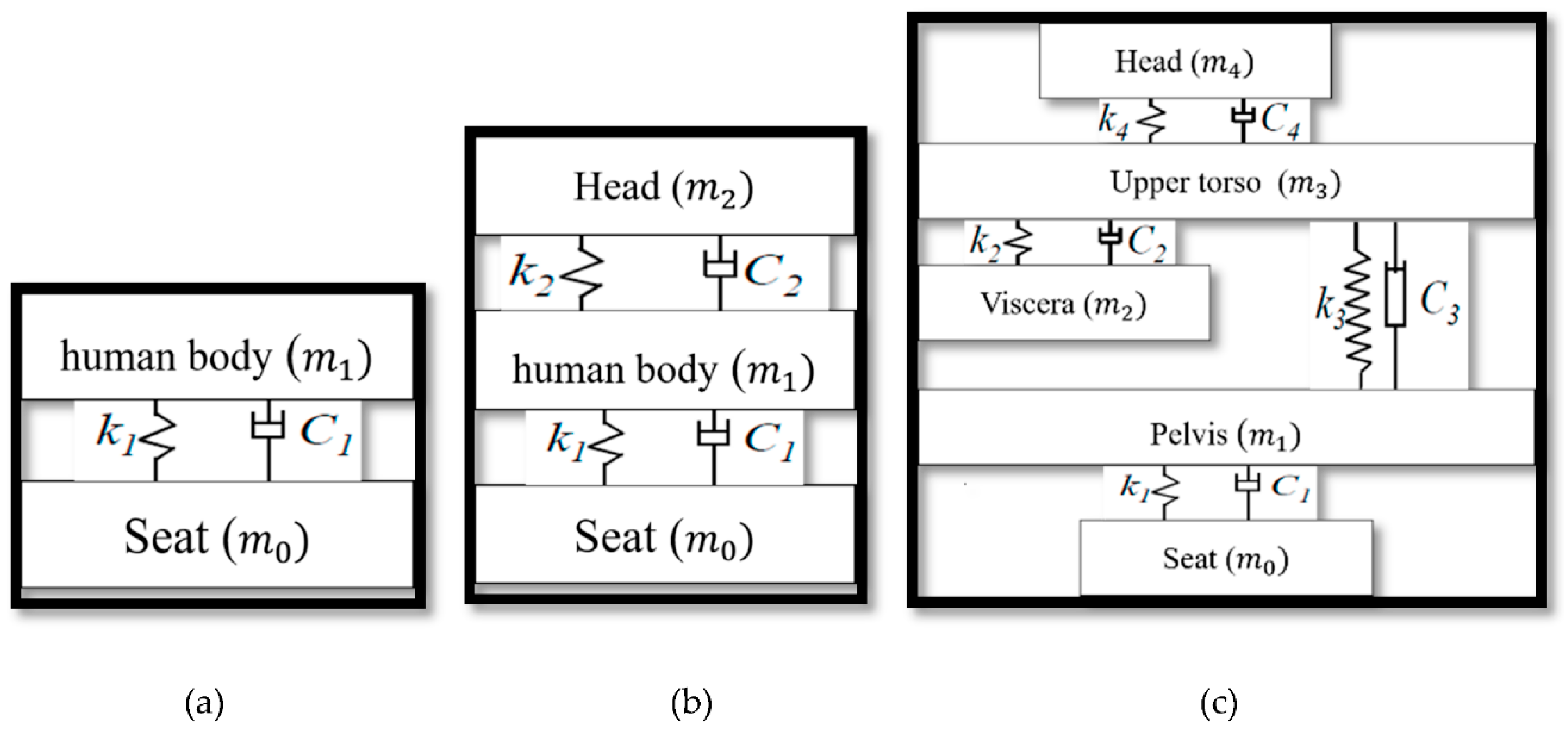



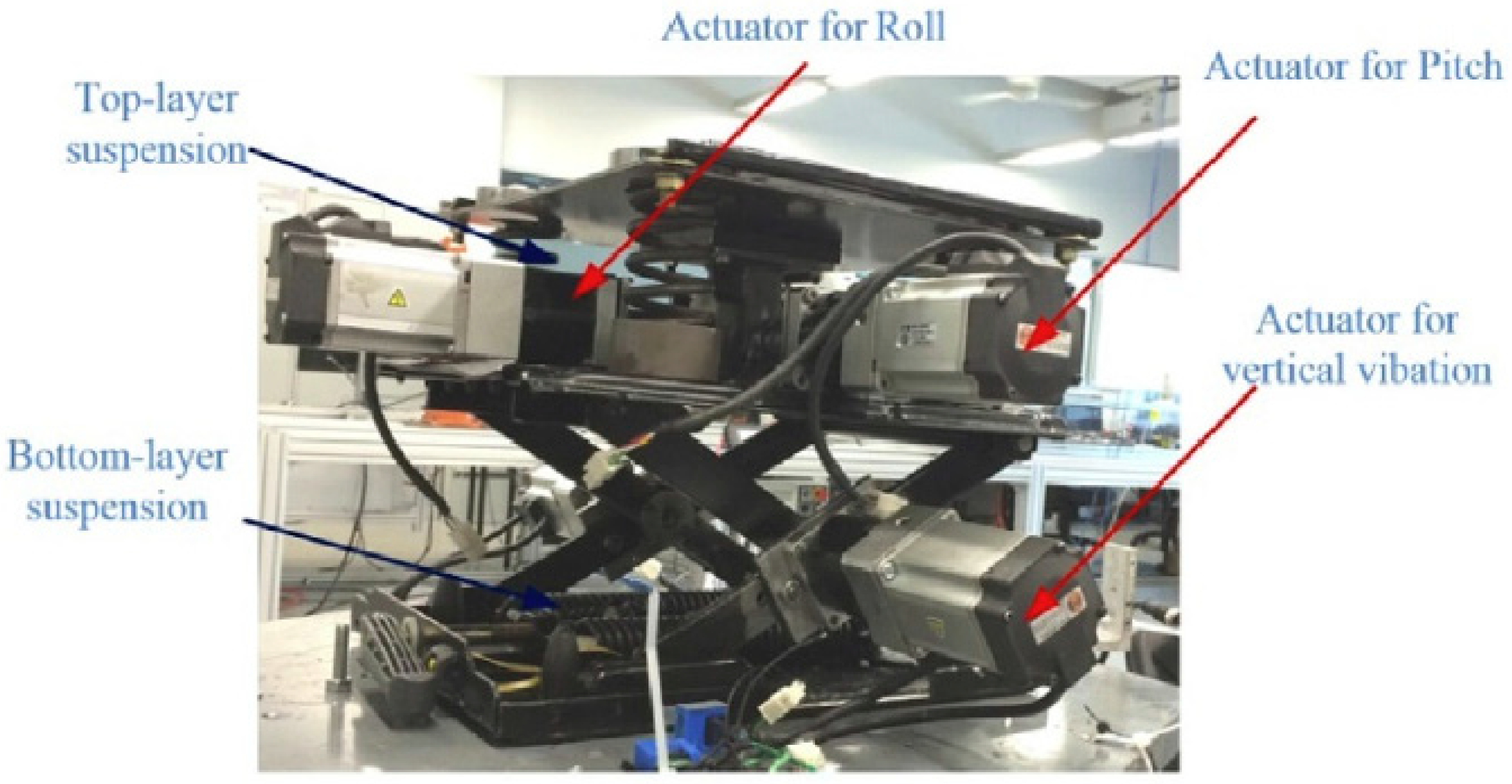


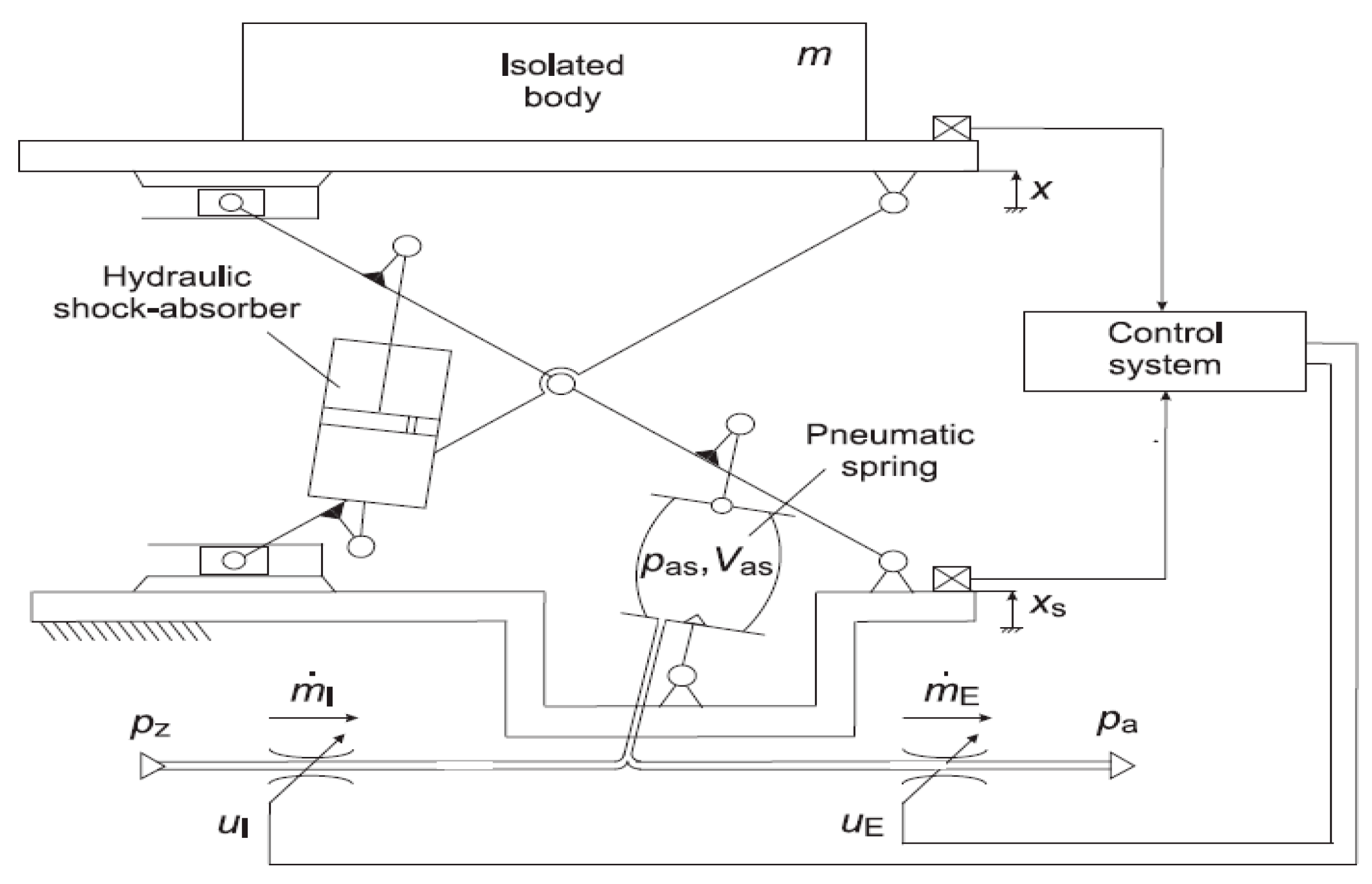
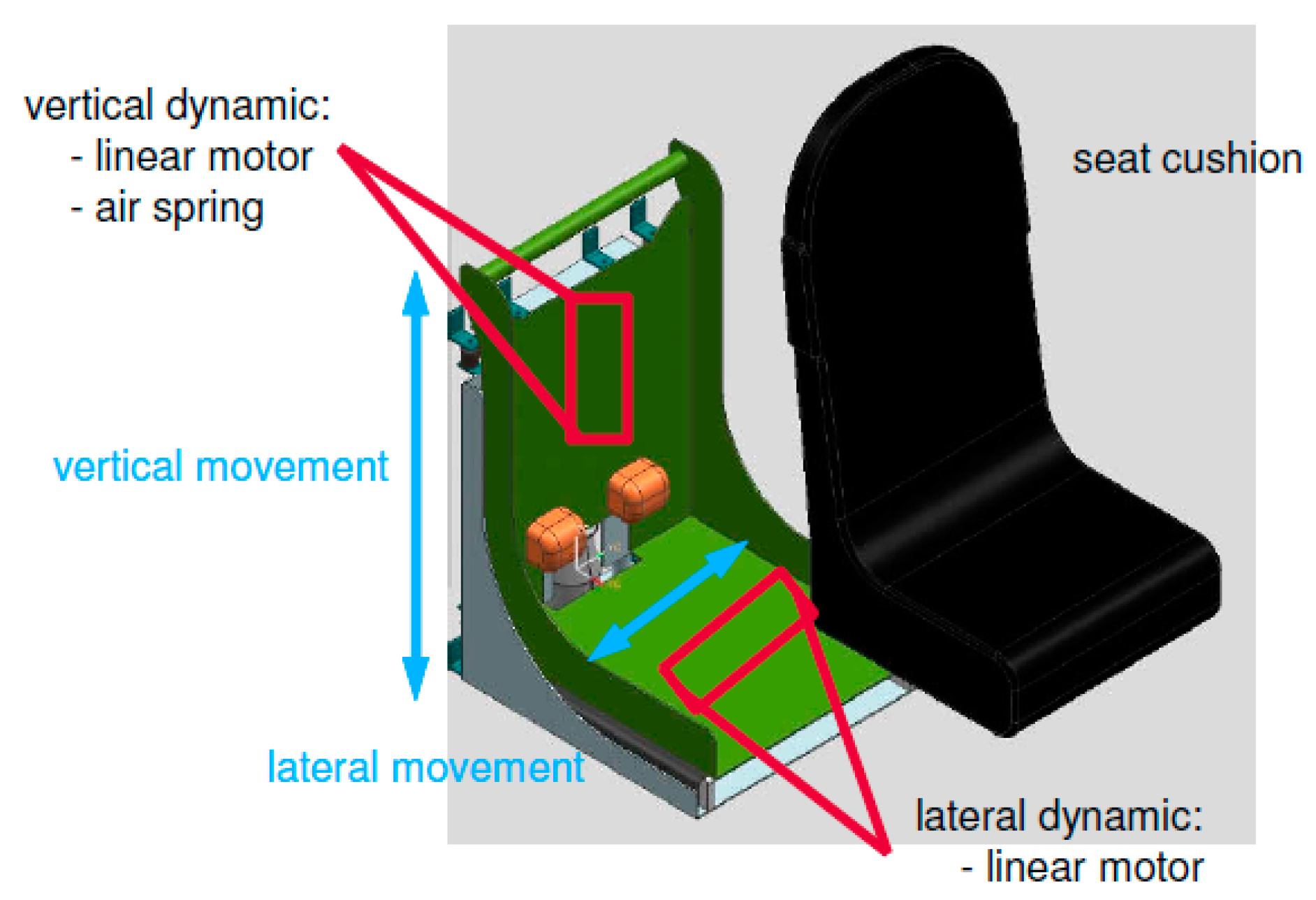
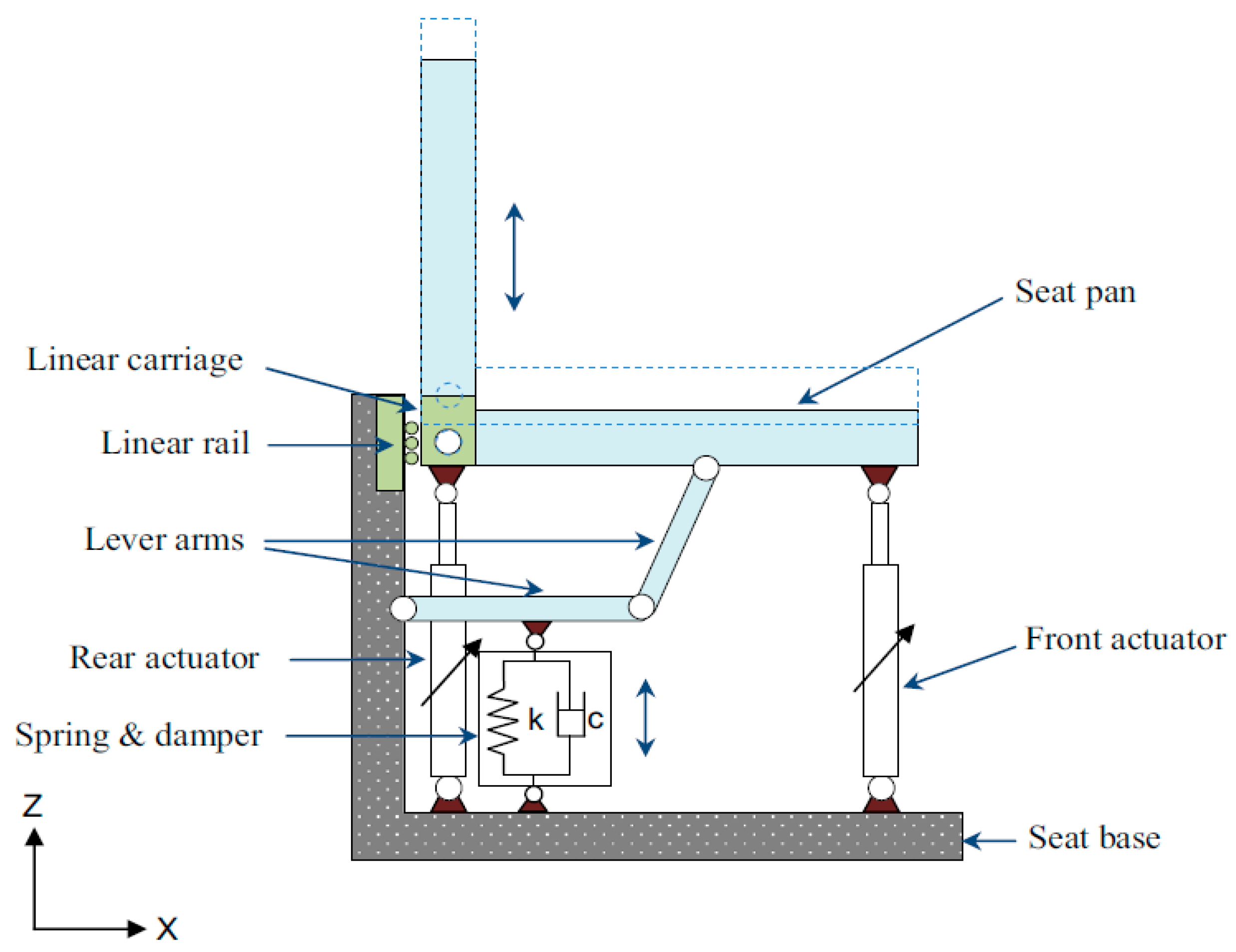

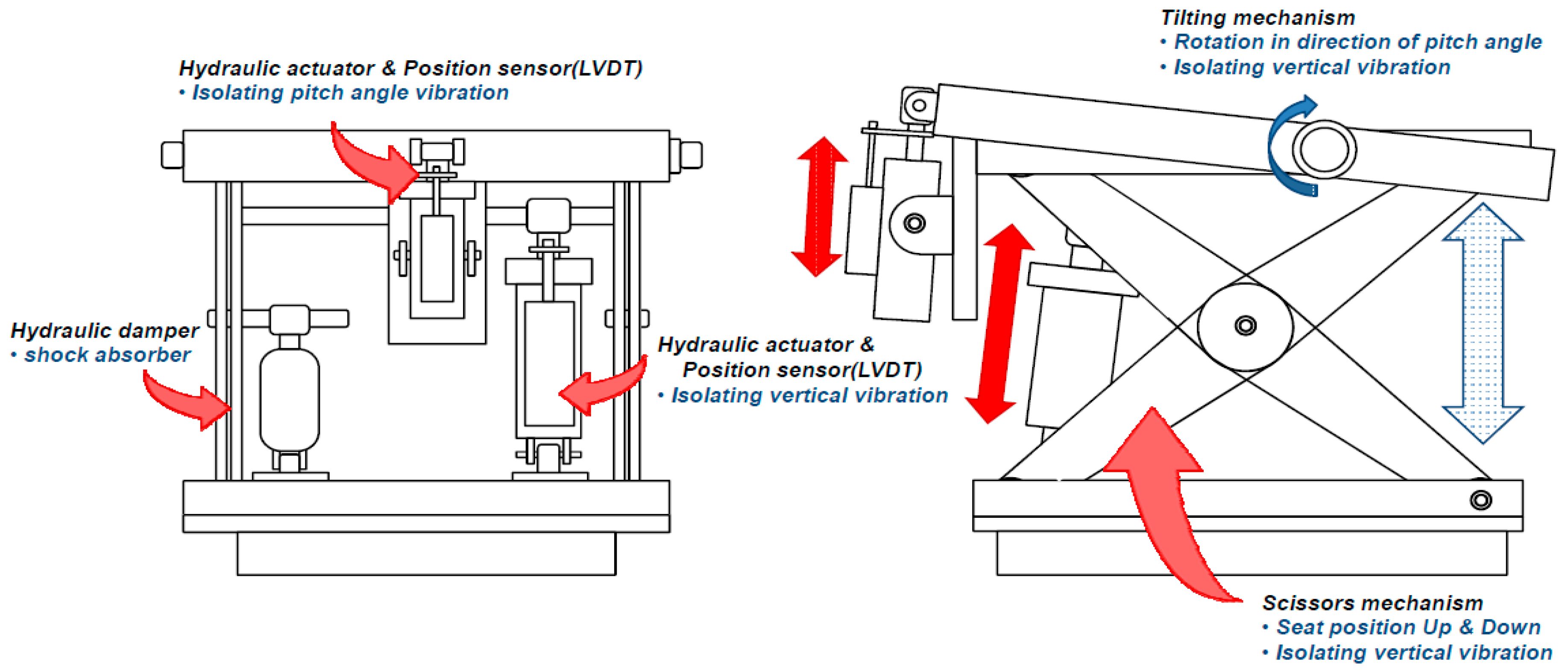

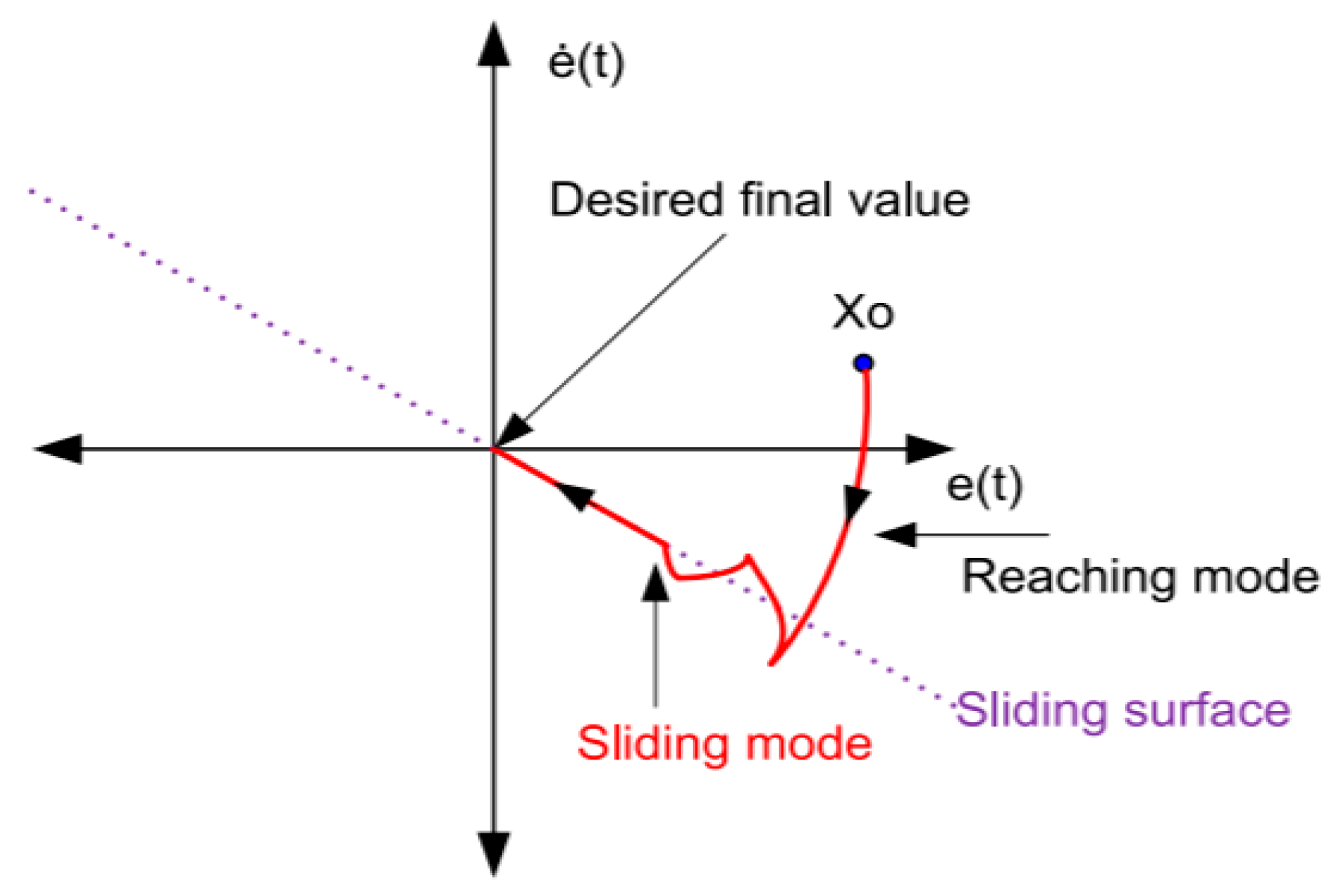

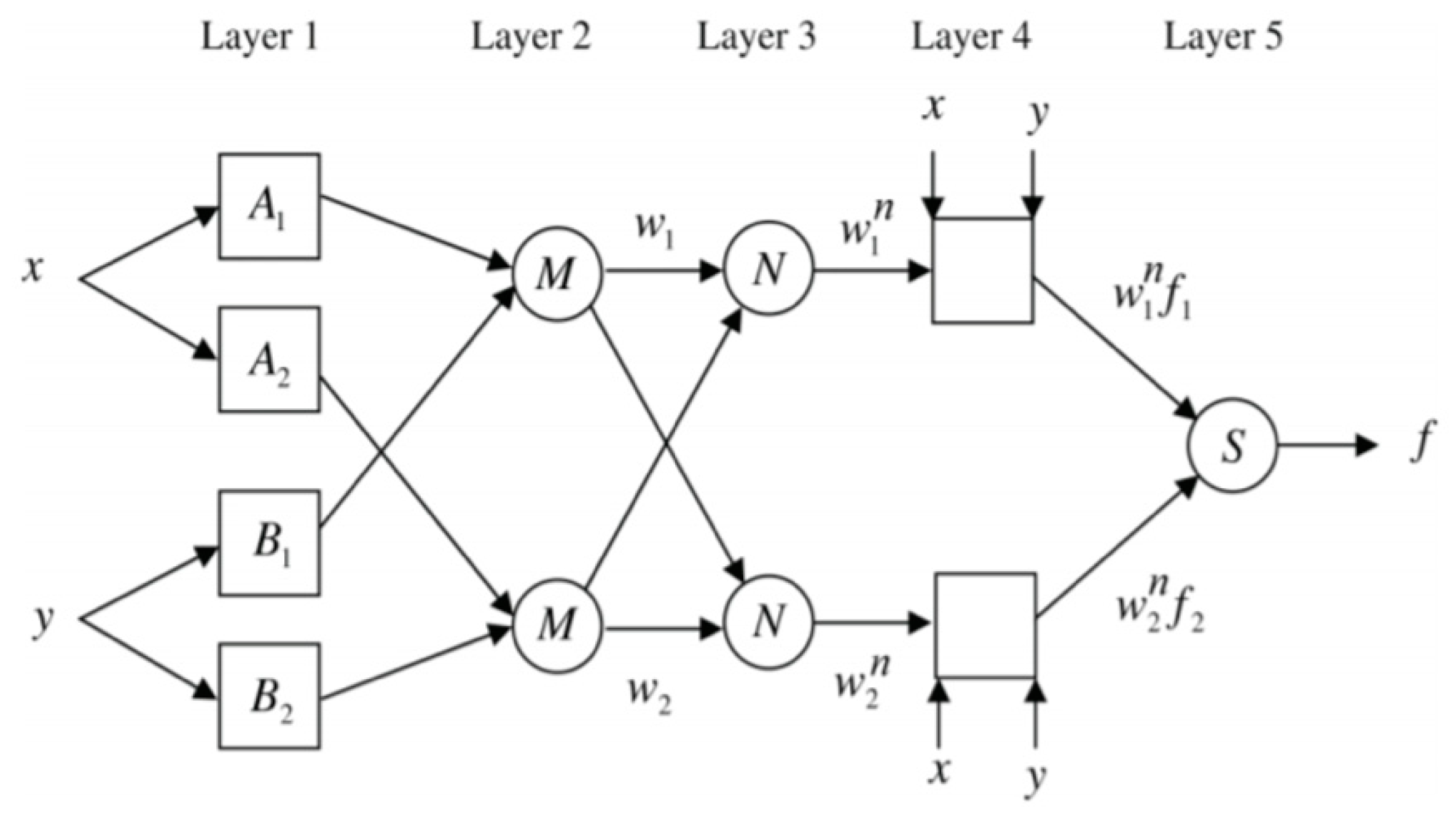

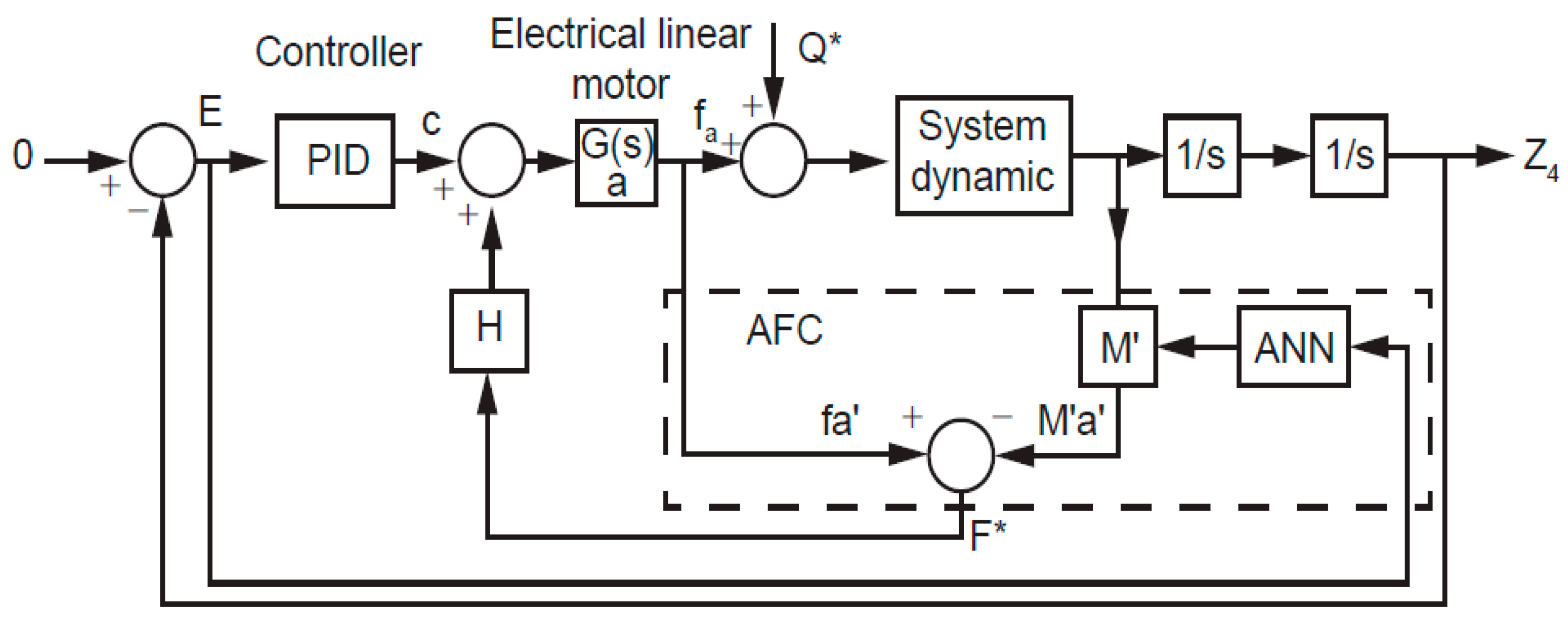
| Weighted Acceleration (m/s2) | ISO Comfort Level |
|---|---|
| <0.315 | Not uncomfortable |
| 0.315–0.63 | A little uncomfortable |
| 0.5–1 | Fairly uncomfortable |
| 0.8–1.6 | Uncomfortable |
| 1.25–2.5 | Very uncomfortable |
| >2 | Extremely uncomfortable |
| References | Type of Actuator System | Degree of Freedom | Summary |
|---|---|---|---|
| [48] | Pneumatic actuator | Vertical and lateral translation | Decoupled controllers were designed in the frequencies between 0.5 and 1 Hz. Experimentally measured vibration amplitude reduction in a single direction is 70%. Reduction of 20% is evident when the lateral and vertical vibration controls are integrated |
| [50] | Linear actuator + Air spring | Vertical and lateral translation | Dynamic feedforward Controller (DFC) and Hybrid Vibration Control (HVC) were used. Experimentally measured vibration amplitude reductions in the vertical direction are 39% and 36% using HVC and DFC, respectively. No reduction in the lateral direction was observed. |
| [51] | Hydraulic actuator | Vertical and pitch motions | Fast Fourier Transform (FFT) analysis based on ISO 5007. The results showed that the active seat suspension is stable in the frequency range of 0–5 Hz. |
| [49] | Rotary servo motors | Vertical and roll motion | Two decoupled controllers were implemented. Experimentally measured vibration amplitude reductions in FW-RMS are 29.8% in health evaluation and 23.6% in ride comfort. |
| References | Control Methods | Actuator Type | Biodynamic Model | Summary |
|---|---|---|---|---|
| [76] | H∞ With friction compensation | Rotary Servo motors | 1 DOF seat suspension model | Experimentally measured RMS Reduction by 57%, VDV and SEAT reduction by approximately 35% |
| [75] | H∞ with friction compensation | Rotary servo motors | 2 DOF seat suspension model | Experimentally measured RMS reduction by 32%, VDV and SEAT reduction by approximately 43% |
| [45] | H∞ with disturbance observer-based T-S fuzzy | Rotary servo motors | 2 DOF seat suspension model | Driver mass variation was considered in the design. Experimentally measured RMS reduction by 45.5% |
| [77,78] | H∞ | - | 3 DOF quarter-car suspension model | Numerical results. Time domain results |
| [80] | H∞ | - | 3 DOF seat suspension model | Finite frequency range. Numerical results. Acceleration PSD plots and Time domain results. |
| [92] | SMC State observer and disturbance observer are used to estimate the uncertainty | - | 8 DOF quarter-car suspension model and passenger model | Simulated SEAT reduction by 80%. RMS Reduction by 77.6% |
| [91] | TSMC State observer are used to reduce the SMC chatter. Disturbance observer is used to estimate the absolute seat velocity. | Rotary servo motors | 6 DOF seat and passenger car quarter suspension models | Experimentally measured RMS reduction by 54.6%, VDV reduction in by 32.6% and SEAT reduction by 34.1% |
| [69] | Primary and secondary controller with adaptation mechanism | Hydraulic shock absorber and pneumatic spring | 1 DOF seat suspension model | Experimentally measured reduction of SEAT value by 45% with low human body mass (50 kg) and reduction of SEAT value by 38% with high human body mass (120 kg). |
| [83] | PID Controller with Feedforward (preview information) and feedback states | Electromagnetic linear actuator | 4 DOF quarter-car suspension model | Experimentally measured reduction of the SEAT value and RMS acceleration by 25% |
| [64] | SMC and ANFIS | - | 3 DOF quarter-car suspension model | Numerical simulation with VDV reduction by 71% from the passive to active quarter-car suspension model |
| Controller Type | Advantages | Disadvantages |
|---|---|---|
| H∞ | • High stability | • High level of mathematical complexity • Large control efforts |
| Preview controller | • Guarantee good vibration attenuation performance in the vertical direction | • Costly • Consumes energy • Takes longer time to estimate the road condition |
| Sliding mode controller | • Ensure high stability in presence of the disturbances and noise. | • Chatter problem, which leads to system damage. |
| Adaptive controller | • Robust controller. • Provide high periodic vibration attenuation performance | • The reference model is critical • Parameter variation |
| Active Force Control | • Efficient to reduce the disturbances • Simple design | • High force could easily damage the system |
| PID | • Simple. • Easy-to-implement. • Low cost control strategies. • Highly effective. | • Diffident tuning methods for each process • Difficult to achieve a fast response with small overshoot. |
© 2020 by the authors. Licensee MDPI, Basel, Switzerland. This article is an open access article distributed under the terms and conditions of the Creative Commons Attribution (CC BY) license (http://creativecommons.org/licenses/by/4.0/).
Share and Cite
Al-Ashmori, M.; Wang, X. A Systematic Literature Review of Various Control Techniques for Active Seat Suspension Systems. Appl. Sci. 2020, 10, 1148. https://doi.org/10.3390/app10031148
Al-Ashmori M, Wang X. A Systematic Literature Review of Various Control Techniques for Active Seat Suspension Systems. Applied Sciences. 2020; 10(3):1148. https://doi.org/10.3390/app10031148
Chicago/Turabian StyleAl-Ashmori, Mohammed, and Xu Wang. 2020. "A Systematic Literature Review of Various Control Techniques for Active Seat Suspension Systems" Applied Sciences 10, no. 3: 1148. https://doi.org/10.3390/app10031148
APA StyleAl-Ashmori, M., & Wang, X. (2020). A Systematic Literature Review of Various Control Techniques for Active Seat Suspension Systems. Applied Sciences, 10(3), 1148. https://doi.org/10.3390/app10031148






